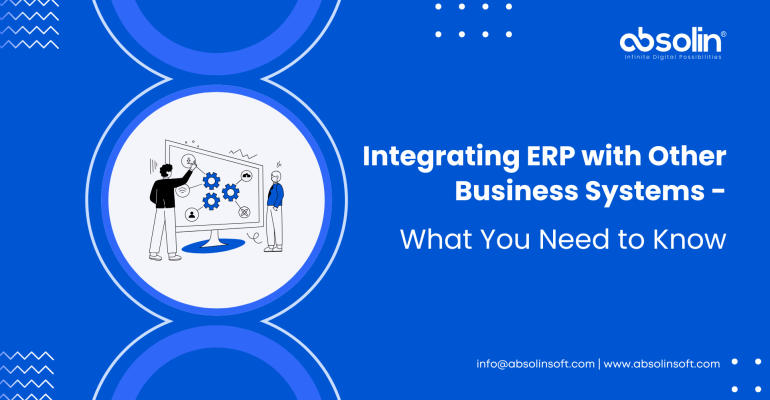Integrating ERP with Other Business Systems: What You Need to Know
Enterprise Resource Planning (ERP) systems have long been a cornerstone for managing core business functions like finance, HR, inventory, procurement, and manufacturing. However, businesses rarely operate with ERP systems alone. To maximize their potential, organizations often use Customer Relationship Management (CRM) systems, e-commerce platforms, Business Intelligence (BI) tools, supply chain management software, and more.
That’s where ERP integration comes into play.
Integrating ERP with other business systems isn’t just a technical necessity—it’s a strategic imperative. Done right, it can streamline operations, reduce data silos, improve decision-making, and ultimately, drive growth. But the integration process can be complex. This blog will unpack everything you need to know about integrating ERP with other systems—benefits, challenges, approaches, and best practices.
Why Integrate ERP with Other Business Systems?
At its core, ERP integration is about connecting your ERP with other tools so that data can flow seamlessly between them. When integrated properly, your ERP becomes the central hub of information, and other systems communicate with it in real time.
Here’s why that’s important:
1. Eliminate Data Silos
Without integration, different departments may rely on disconnected systems. This leads to duplicate data entry, miscommunications, and conflicting information. Integration ensures that every part of your organization works from the same, up-to-date data.
2. Improve Efficiency and Accuracy
Manual data entry between systems is time-consuming and prone to error. Integration automates data exchange, reducing human error and improving workflow efficiency.
3. Enable Real-Time Decision-Making
When all business systems are interconnected, decision-makers get real-time insights into sales, inventory, finance, and customer behavior. This allows for more agile and informed decision-making.
4. Enhance Customer Experience
Integrating ERP with systems like CRM or e-commerce platforms ensures that customer data, order statuses, and inventory levels are synced—leading to faster service and better customer satisfaction.
5. Support Scalability
As your business grows, so do your operational needs. A well-integrated system architecture makes it easier to adopt new technologies, scale operations, and enter new markets.
Common ERP Integrations
Businesses typically integrate ERP systems with:
- CRM (e.g., Salesforce, HubSpot): Sync customer data, sales pipelines, orders, and invoices.
- E-Commerce Platforms (e.g., Shopify, Magento, WooCommerce): Automatically update inventory, product details, and order statuses.
- Business Intelligence Tools (e.g., Power BI, Tableau): Aggregate ERP data for advanced reporting and visualization.
- Supply Chain & Inventory Systems: Ensure real-time updates on inventory levels, procurement status, and delivery timelines.
- Human Resource Management Systems (HRMS): Integrate payroll, benefits, and employee records with finance and operations.
- Accounting Software: Maintain consistency between financial records, expense tracking, and tax reporting.
Approaches to ERP Integration
There are several technical approaches to integrating ERP systems with other business tools:
1. Point-to-Point Integration
- Involves direct connections between each system.
- Simple and cost-effective for small businesses.
- Cons: Doesn’t scale well; adding new systems creates a complex web of connections.
2. Middleware-Based Integration
- Uses a middleware platform (like MuleSoft, Dell Boomi, or Zapier) to act as a communication bridge.
- Provides centralized management, scalability, and flexibility.
- Ideal for: Medium to large enterprises with multiple systems.
3. API Integration
- Many modern ERP systems and third-party applications offer APIs (Application Programming Interfaces).
- APIs enable real-time, bi-directional data exchange.
- Highly customizable, but requires development resources and careful security management.
4. Enterprise Service Bus (ESB)
- A more advanced architecture that manages communication between multiple services.
- Supports complex integrations and data transformations.
- Best suited for large organizations with high integration complexity.
Challenges of ERP Integration
While the benefits are compelling, ERP integration is not without its challenges:
❌ Data Incompatibility
Different systems may store data in different formats or structures, requiring data mapping and transformation before syncing.
❌ Integration Complexity
As more systems are added, integration becomes more complex. Without proper architecture, it can turn into a “spaghetti mess.”
❌ Cost and Time
Integration projects can require significant investment in both time and resources—especially when developing custom APIs or middleware.
❌ Security and Compliance Risks
Data flowing between systems must be encrypted and managed securely. Integrations can open up vulnerabilities if not properly secured.
❌ Maintenance and Updates
Each time a connected system updates or changes its API, the integration may break and need maintenance.
Best Practices for ERP Integration
To ensure a successful ERP integration, businesses should follow these best practices:
✅ Start with Clear Objectives
Define your integration goals—whether it’s automating a specific process, improving data accuracy, or enhancing reporting.
✅ Choose the Right Integration Method
Select the integration approach that fits your current systems, budget, and scalability needs. Avoid point-to-point if you plan to grow.
✅ Prioritize Data Quality
Clean and normalize your data before integration to avoid syncing errors and reporting inaccuracies.
✅ Involve All Stakeholders
Include input from all departments involved. This ensures that the integration aligns with real business needs and gains organization-wide support.
✅ Use Standardized APIs
When possible, choose systems with open and well-documented APIs. This reduces integration time and eases future upgrades.
✅ Ensure Security and Compliance
Implement strong access controls, encryption, and compliance checks (e.g., GDPR, HIPAA) to protect sensitive data.
✅ Monitor and Optimize
After integration, continuously monitor the performance of your connected systems. Use analytics to identify bottlenecks and improve workflows over time.
Future Trends in ERP Integration
As technologies evolve, ERP integration is becoming more intelligent and accessible:
- AI-Powered Integrations: AI can automate mapping, detect anomalies, and optimize workflows in real time.
- iPaaS (Integration Platform as a Service): Cloud-based platforms make it easier to manage integrations without heavy IT investment.
- Event-Driven Architectures: Enable systems to respond to real-time events, reducing delays and improving responsiveness.
- Low-Code/No-Code Integration Tools: These tools empower non-developers to build and manage basic integrations with drag-and-drop interfaces.
Conclusion
Integrating your ERP system with other business applications is no longer optional—it’s a fundamental strategy for modern businesses seeking agility, efficiency, and competitive advantage. While integration can be complex, with the right approach, technology, and planning, businesses can unlock immense value from their connected ecosystem.
A successful ERP integration can turn fragmented data into powerful insights, streamline operations, and create a unified experience for both employees and customers. Whether you’re a small business scaling up or an enterprise undergoing digital transformation, integration is the key to building a smarter, more connected future.



